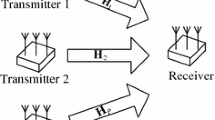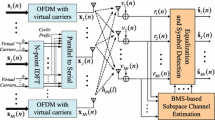Abstract
An improved blind channel equalization method is proposed based on the generalized eigenvector algorithm (GEA) in this paper. This new method can blindly equalize the desired signal in the presence of strong co-channel interference. The basic idea underlying the improved GEA method is that higher-order cumulants can be sensitive to frequency offset. By exploiting this property of higher-order statistics, blind equalizer can be designed to equalize the desired signal with known frequency offset while suppressing the interference with a different frequency offset. Simulation results are shown to demonstrate the effectiveness of the proposed method.







Similar content being viewed by others
References
A. Batra, J.R. Barry, Blind cancellation of co-channel interference, in IEEE Global Telecommunications Conference (GLOBECOM, Singapore, 1995), pp. 157–162d
Z. Ding, Y. Li, Blind Equalization and Identification (CRC, New York, 2001)
O.A. Dobre, A. Abdi, Y. Bar-Ness, W. Su, Cyclostationarity-based modulation classification of linear digital modulations in flat fading channels. Wirel. Person. Commun. 54(4), 699–717 (2010)
M.L. Downey, J.C. Chu, System for and method of removing unwanted inband signals from a received communication signal. US Patent 8929492-B2 (2015)
D. Godard, Self-recovering equalization and carrier tracking in two-dimensional data communications systems. IEEE Trans. Commun. 28(11), 1867–1875 (1980)
B. Jelonnek, D. Boss, K.D. Kammeyer, Generalized eigenvector algorithm for blind equalization. Signal Process. 61(3), 237–264 (1997)
J. Mendel, Tutorial on higher-order statistics (spectra) in signal processing and system theory: theoretical results and some applications. Proc. IEEE 79(3), 278–305 (1991)
C.L. Nikias, M.R. Raghuveer, Bispectrum estimation: a digital signal processing framework. Proc. IEEE 75(7), 869–891 (1987)
J. Proakis, M. Salehi, Digital Communications (McGraw-Hill Education, New York, 2007)
Y. Sato, A method of self-recovering equalization for multilevel amplitude modulation systems. IEEE Trans. Commun. 23(6), 679–682 (1975)
J. Treichler, B. Agee, A new approach to multipath correction of constant modulus signals. IEEE Trans. Accoust. Speech Signal Process. 31(2), 459–471 (1983)
J. Treichler, M. Larimore, New processing techniques based on the constant modulus adaptive algorithm. IEEE Trans. Accoust. Speech Signal Process. 35(2), 420–431 (1985)
S. Tu, H. Zheng, N. Gu, Single-channel blind separation of two QPSK signals using per-survivor processing, in Proceedings of Asia Pacific Conference on Circuits and Systems (IEEE, Macao, 2008), pp. 1–5
E.S. Warner, I.K. Proudler, Single-channel blind signal separation of filtered MPSK signals. IEEE Proc. Radar Sonar Navig. 150(6), 396–402 (2003)
Author information
Authors and Affiliations
Corresponding author
Rights and permissions
About this article
Cite this article
Wang, G., Kapilan, B., Razul, S.G. et al. Blind Equalization in the Presence of Co-channel Interference Based on Higher-Order Statistics. Circuits Syst Signal Process 37, 4150–4161 (2018). https://doi.org/10.1007/s00034-017-0744-x
Received:
Revised:
Accepted:
Published:
Issue Date:
DOI: https://doi.org/10.1007/s00034-017-0744-x




